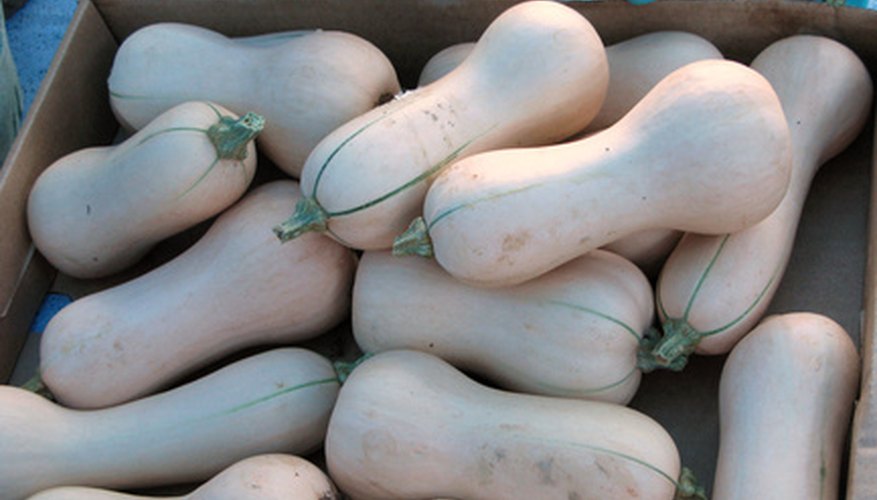Butternut squash is a type of winter squash that enjoys full sunlight exposure and rich, well-draining soil. If you have enough garden space to grow butternut squash, you'll find that the plants are relatively easy to grow and demand only basic care. You'll need to apply fertiliser at two different times during the growing season.
Site Preparation
The first fertiliser application that you'll need to make is when you're preparing the planting site for your butternut squash plants. When you're loosening the soil bed using a garden fork or rototiller, spread up to 4 inches of well-rotted organic compost on the bed. Mix the compost into the soil to a depth of about 12 inches. Then, apply 4 to 6 cups of all-purpose garden fertiliser per 100 square feet of soil bed row, or at a rate of 13.6kg. per 1,000 square feet.
- The first fertiliser application that you'll need to make is when you're preparing the planting site for your butternut squash plants.
- When you're loosening the soil bed using a garden fork or rototiller, spread up to 4 inches of well-rotted organic compost on the bed.
NPK Formula
A soil test can tell you the correct fertiliser formula for your garden bed, including what nutrients you should add for growing butternut squash. Like other types of winter squash, butternut squash plants prefer a soil pH of 6.2 to 6.5. In the absence of a soil test, you can use a basic NPK formula for vegetable plants, such as a 5-10-10, 10-10-10 or 16-16-8 NPK formula. Add one of these types of NPK fertilisers to the garden bed prior to planting your butternut squash seeds or transplants.
- A soil test can tell you the correct fertiliser formula for your garden bed, including what nutrients you should add for growing butternut squash.
Sidedressing
The second fertiliser application for butternut squash plants is when the first flower blooms emerge, after the plants develop runners on the vines. When you see the first blooms, apply a side-dressing of calcium nitrate, spreading the fertiliser about 6 to 8 inches away from the plants on both sides of the row. You can side-dress the butternut squash plants at a rate of 0.907kg. calcium nitrate per 100 feet row. Another type of fertiliser that you can use to for this side-dressing application is a 21-0-0 NPK formula, at a rate of 1 to 2 tbsp per plant.
- The second fertiliser application for butternut squash plants is when the first flower blooms emerge, after the plants develop runners on the vines.
- Another type of fertiliser that you can use to for this side-dressing application is a 21-0-0 NPK formula, at a rate of 1 to 2 tbsp per plant.
Considerations
When you side-dress the butternut squash plants with fertiliser, make sure that you water it in thoroughly, so that the fertiliser granules dissolve into the soil. Also, avoid getting the fertiliser on the plant itself. If your garden soil is sandy or your area experiences heavy, leaching rains, you might need to apply additional side-dressings of fertiliser or side-dress at lower rates but more frequently. Avoid overfertilizing the butternut squash plants with lots of nitrogen, because doing so can promote excessive vegetative growth at the expense of squash yield.
- When you side-dress the butternut squash plants with fertiliser, make sure that you water it in thoroughly, so that the fertiliser granules dissolve into the soil.
